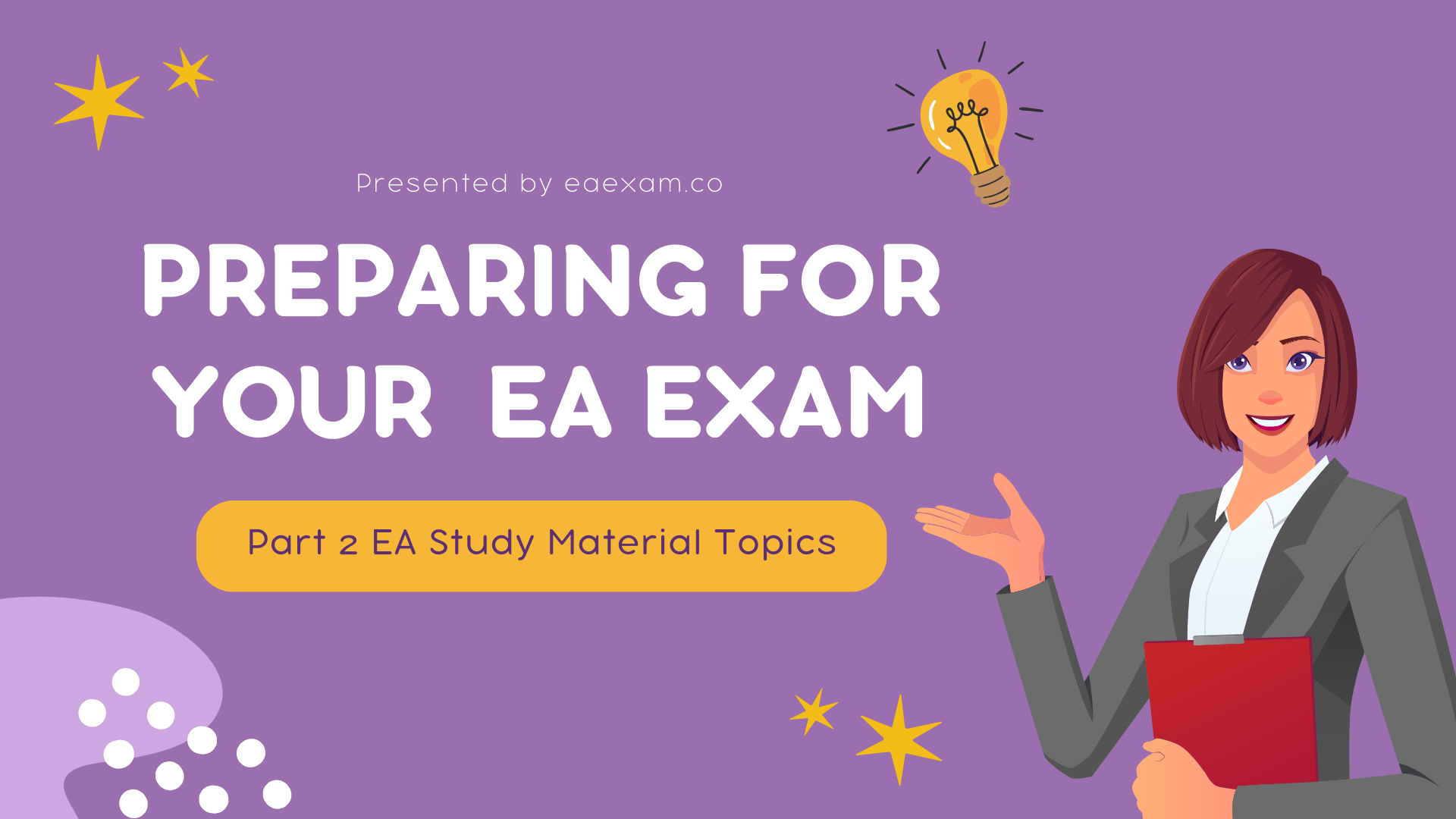The second part of the IRS enrolled agent exam focuses on businesses. It covers EA study material topics such as business entities, accounting methods, depreciation, cost recovery, business deductions, employee compensation, and retirement plans.
Specifically, the exam tests knowledge of the tax treatment of different types of business entities, including partnerships, S corporations, and C corporations. It also covers accounting methods, including cash and accrual accounting, and the rules for calculating depreciation and cost recovery.
Additionally, the exam tests the ability to identify and calculate business deductions, such as advertising expenses, employee compensation, and rent expenses.
Finally, the exam covers the rules for employee compensation and retirement plans, including contributions and distributions. Overall, the second part of the exam assesses an individual’s knowledge of taxation related to businesses and their finances.

EA Study Material Topics Detail
Part 2 — Businesses: EA Study Material
- Business Entities and Considerations– 30 questions
- Business Tax Preparation – 37 questions
- Specialized Returns and Taxpayers – 18 questions
Here’s a more detailed EA study material topics breakdown of the second part of the IRS EA exam:
-
Business Entities: This topic covers the different types of business entities, including sole proprietorships, partnerships, S corporations, and C corporations. It also covers the tax treatment of each type of entity.
-
Accounting Methods: This EA study material topic covers the different accounting methods that businesses can use, including cash and accrual accounting. It also covers the rules for changing accounting methods.
-
Depreciation: This topic covers the rules for calculating and claiming depreciation for business assets, including the different methods of depreciation, such as straight-line and accelerated depreciation.
-
Cost Recovery: This EA study material topic covers the rules for claiming cost recovery deductions for business assets, including the Section 179 deduction and bonus depreciation.
-
Business Deductions: This topic covers the different types of business deductions that are available, including advertising expenses, employee compensation, rent expenses, and other ordinary and necessary expenses.
-
Credits for Businesses: This EA study material topic covers the various tax credits that are available to businesses, including the research and development credit and the work opportunity credit.
-
Accounting Periods and Methods: This topic covers the rules for choosing an accounting period and method for tax purposes.
-
Employee Compensation: This EA study material topic covers the rules for paying and reporting employee compensation, including the calculation of payroll taxes.
-
Retirement Plans: This topic covers the different types of retirement plans that businesses can offer, including 401(k) plans and Simplified Employee Pension (SEP) plans. It also covers the rules for contributions and distributions.
-
Business Tax Returns: This EA study material topic covers the different types of tax returns that businesses may need to file, including Form 1120 for corporations and Form 1065 for partnerships.
-
Partnership Taxation: This topic covers the rules for partnership taxation, including the allocation of income and deductions among partners and the reporting of partnership income on individual tax returns.
-
S Corporation Taxation: This EA study material topic covers the rules for S corporation taxation, including the requirements for electing S corporation status and the calculation of income and deductions.
-
C Corporation Taxation: This topic covers the rules for C corporation taxation, including the calculation of income and deductions and the rules for calculating the Alternative Minimum Tax.

SEE: Part 2 — Businesses – EA Study Material Domains
EA Study Material Domain 1: Business Entities and Considerations 30 Questions
1.1. Business Entities
- Sole proprietorships
- Partnerships and qualified joint ventures (QJV)
- Corporations
- S corporations
- LLCs
- Tax-exempt entities and associations
- Entity type default classifications and elections
- Employer identification number
- Accounting periods (tax year)
- Reporting requirements (e. g., Forms W-2, W-4, Form 1099)
- Hobby versus business determination and loss limitations
1.2. Partnerships
- Partnership income, expenses, distributions, and flow-through (e. g., self-employment income) -Family partnerships
- Partner’s dealings with partnership (e. g., exchange of property, guaranteed payments)
- Contribution of property and/or services to a partnership (e. g., partnership’s basis, property subject to indebtedness)
- Basis of partner’s interest
- Disposition of partner’s interest
- Partnership formation (e. g., partnership agreement, general vs limited partners, capital contributions)
- Dissolution of partnership (e. g., sale, death of partner)
- Filing requirements, due dates, penalties, and audit notice requirements
- Partnership cancellation of debt
- Partnership level audit and opt-out
1.3. Corporations in general
- Filing requirements, due dates, and penalties
- Earnings and profits
- Shareholder dividends, distributions, and recognition requirements
- Special deductions and credits (e. g., dividends received deductions, charitable deduction) -Liquidations and stock redemptions
- Accumulated earnings tax
- Estimated tax payments
- Corporate minimum tax credit
1.4. Forming a corporation
- Services rendered to a corporation in return for stock
- IRC section 351 exchange
- Transfer and/or receipt of money or property in addition to corporate stock -Transfer of property subject to indebtedness
- Controlled groups
- Closely held corporations
1.5. S corporations
- Requirements to qualify (e. g., qualifying shareholders)
- Election procedure
- Income, expenses and separately stated items
- Treatment of distributions
- Shareholder’s basis (e. g., loan basis, distributions and losses in excess of basis, services for stock)
- Revocation, termination and reinstatement
- Debt discharge
EA Study Material Domain 2: Business Tax Preparation 37 Questions
2.1. Business Income
- Gross receipts and other income
- Cost of goods sold (e. g., inventory practices, expenditures included, uniform capitalization rules)
- Net income/loss and at-risk limitations
- Cancellation of business debt
2.2. Business expenses, deductions and credits
- Officers and employees’ compensation (e. g., deductibility, fringe benefits, rules of family employment, statutory employee, necessary and reasonable)
- Business rental deduction, including self-rentals
- Depreciation, amortization (start-up and organizational cost), IRC section 179, depletion, bonus depreciation, and correcting errors
- Business bad debts
- Business travel, meals, and gift expenses
- Vehicle use and expenses
- Interest expense
- Insurance expense
- Taxes (e. g., deductibility of taxes, assessments, and penalties; proper treatment of sales taxes paid, excise)
- Employment taxes
- Casualties, thefts, and condemnations
- Qualified business income(QBI) (e.g., SSTB, calculations, phase out, UBIA)
- Eligibility and deductibility of general business credits (e. g., disabled access credit, R & D credit, small business healthcare tax credit, foreign tax credit)
- Net operating loss deduction
- Home office
2.3. Business assets
- Basis of assets
- Disposition of property or assets
- Like kind exchange
- Converted property
- Capitalization and repair regulations (e. g., elections)
2.4. Analysis of financial records
- Proper business type, the use of classification codes, and year to year comparison -Income statement
- Balance sheet (e. g., proofing beginning and ending balances, relationship to income statement and depreciation)
- Method of accounting and changes (e. g., accrual, cash, hybrid, Form 3115)
- Depreciation recovery (e. g., recapture, IRC sec 280F)
- Pass-through activity (e. g., K-1, separately stated items, non-deductible expenses) -Reconciliation of tax versus books (e. g., M-1, M-2, M-3)
- Related party activity
- Loans to and from owners
2.5. Advising the business taxpayer
- Reporting and filing obligations (e. g., extended returns and potential penalties, international information returns, Form 1099 series, Form 8300)
- Payments and deposit obligations (e. g., employment tax, excise tax)
- Record-keeping requirements (e. g., mileage log, accountable plans)
- Selection of business entity (e. g., benefits and detriments)
- Comingling (e. g., personal usage of business accounts, separation of business and personal accounts)
- Advice on accounting methods and procedures (e. g., explanation of requirements) -Transfer of property in or out of the business
- Life cycle of the business (e. g., formation, dissolution)
- Type of industry (e. g., specified service business owners)
- Worker classification (e.g., independent contractor versus employee, outside sales, full-time versus part-time)
- Deductions and credits for tax planning (e.g., timing of income and expenses, NOL, depreciation versus IRC section 179 versus bonus depreciation)
- ACA compliance
EA Study Material Domain 3: Specialized Returns and Taxpayers 18 Questions
3.1. Trust and estate income tax
- Trust types (e. g., simple/complex, grantor, irrevocable, tax shelters, foreign)
- Distributable net income and accounting income
- Exclusions, exemptions, and deductions
- Fraudulent trusts
- Income (e. g., allocations, corpus versus income)
- Separately stated items (e.g., items reported on the K-1)
- Filing requirements, tax years, and penalties
3.2. Exempt organizations
- Qualifying for and maintaining tax-exempt status (e. g., IRC 501(c))
- Applying for IRS tax-exempt status (e. g., Form 1023, Form 1024)
- Filing requirements (e. g., Form 990 series)
- Unrelated business taxable income
3.3. Retirement plans
- Employer and employee contributions
- Reporting requirements
- Plans for self-employed persons (e. g., SEP and SIMPLE)
- Prohibited transactions
- Qualified and non-qualified plans
- Non-discrimination rules
3.4. Farmers
- Farm income (e.g., livestock, crop insurance proceeds, subsidies, patronage dividends, conservation payments)
- Depreciation for farmers
- Disaster-area provisions (e.g., drought, flood, other weather-related conditions) -Farm rental (e.g., Form 4835)
- Farm tax computation (e.g., Schedule J, Schedule SE, estimated tax)
3.5 Rental Property
- Real estate professional qualifications
- Commercial rentals versus residential rentals
- Mixed used property/vacation home
- Passive loss limitation (e.g., special $25,000 allowance, MAGI limits)
- Rental income (e.g., deposits, pre-paid rent, not rented for profit)
- Rental expenses (e.g., allocation between personal and rental, repair versus capitalized)
Overall, the second part of the IRS enrolled agent exam requires a thorough understanding of many EA study material domains such as tax laws and regulations related to businesses and their finances.







